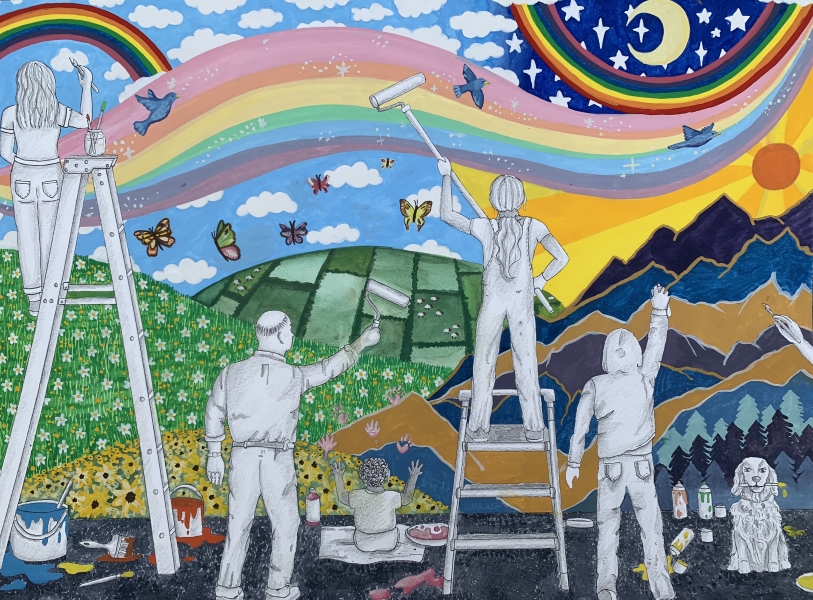
In this post, the authors discuss their research project in which they assessed which Video Conferencing (VC) systems best suited students for socialising when face to face meeting was not an option during the COVID-19 pandemic. Phoebe Mamalouka has recently graduated from a BSc in Artificial Intelligence and Computer Science, and Cristina Adriana Alexandru is a Lecturer in the School of Informatics. This post belongs to the July-August Learning & Teaching Enhancement theme: Learning and Teaching Conference 2023↗️.
Social interaction is essential for Higher Education (HE) students, to settle into university life and develop a sense of belonging to the student community↗️. However, it was severely affected by the Covid-19 pandemic lockdowns. It suddenly stopped being about students meeting course mates after class, chatting to the person next to them in the lecture theatre, or joining societies; all of that was replaced by online meetings over Video Conferencing (VC) systems such as Zoom↗️ or Microsoft Teams↗️. Also known as video call or video chat systems/tools/apps, these systems help to simulate face-to-face meetings online, through the use of live image and sound together with other features that create a shared visual space.
Even if lockdowns are over, it is useful for students to know what to look for in a VC system and how to use VC systems effectively, so that their lives are affected as little as possible when in-person socialisation is not an option.
The aim of this project was to answer the following research questions:
- RQ1: What are the characteristics of beneficial online social interaction?
- RQ2: How did students make use of VC systems for socialisation during the pandemic?
- RQ3: Which features of VC systems made students’ socialisation more/less beneficial?
- RQ4: How do existing VC systems compare in terms of facilitating students’ social interaction?
- RQ5: What usage guidelines can be drawn for students to achieve maximum benefit in their VC social interactions? What design guidelines can be drawn for software developers to make VC systems more suitable for HE students?
To address RQ1-3, a user study involving an online questionnaire was conducted with 65 University of Edinburgh students.
In response to RQ1, some participants preferred online to closely resemble face-to-face social interaction, in order to achieve maximum emotional connection and support. Others, on the contrary, valued online social interaction for its capabilities and advantages over in-person interaction (e.g. screen sharing during a synchronous discussion). Many other participants appreciated the innovative aspects of VC, while still missing face-to-face interaction. Comments suggested that online social interaction should be a complement, and not a substitute, to face-to-face interaction. Other proposed characteristics of beneficial online social interaction were ‘easy to access’, ‘reducing stress’ as compared to face-to-face interaction (e.g. by turning off camera when feeling shy), and ‘engaging’.
The findings for RQ2-RQ3 were enriched by conducting a systematic literature review, led by the PRISMA statement↗️. Only academically published papers from during the pandemic, and which addressed HE students’ experience with VC systems for the purpose of social interaction were included.
Findings for RQ2 revealed that students turned to VC systems to simulate the feeling of co-presence that comes with in-person interaction. During lockdown, they used such systems to create a shared visual-audio space where they could play online games, watch movies, or study together. In an academic context, socialising through online ice breaker sessions and breakout rooms was also very important for many, especially if isolated in their personal life.
For RQ3, the following were identified as beneficial features of VC systems: good quality video and audio, turning camera and microphone on/off, screen sharing, group chat, user-friendly UI, active talk indicator, shared whiteboard, compatibility with many OSs/devices. On the other hand, user study participants did not see how filters, embedded AR games, switching devices mid-call and screen interactivity could enhance the quality of their interaction. Furthermore, they disagreed on the usefulness of noise reduction, which can interfere with the audio quality of the call, and breakout rooms, which are more useful for socialising during class but are not always used effectively by lecturers, or lead to awkward silences. The literature review also revealed that network latency or jitter can make the interaction feel unnatural, and seeing one’s own video can be distracting, cause fatigue and insecurity.
The beneficial features were broken down into more testable sub-features by consulting the literature, and became criteria in a hands-on evaluation of the VC systems identified in the user study and systematic review, to answer RQ4. This evaluation involved giving the systems scores for their inclusion of each beneficial feature and classifying them.
18 VC systems were evaluated (Table 1). The best were found to be, in order, Zoom↗️, Webex↗️ and Tencent Meeting↗️, which achieved consistently high scores (even if not always maximum) in all features. Gather↗️ was also impressive because of its different approach to VC: participants having avatars that co-exist in a virtual space and spontaneously start video calls with other avatars when approaching them. Facebook Messenger↗️ stood out because of its user friendly and easy to use user interface, while Google Meet↗️ because of its high video and audio quality, even though it is accessed through a browser rather than a dedicated app.
Finally, usage and design guidelines were drawn from the results (RQ5). To gain maximum benefits from VC interactions, students are advised to use high quality hardware, adjust room lighting, minimise background noise, take action to reduce internet lag, avoid multitasking, avoid video calls with many participants, and pick activities in advance. To meet students’ social needs, software developers should give them as much freedom as possible as users. For example, students should be able to adjust image and light quality, tune noise reduction, and decide on the number of participants to share content with. Developers can also use Gather as inspiration to address the issue of awkward breakout rooms reported by students.

You can watch Phoebe and Cristina’s conference presentation, ‘Evaluation of Chat and Video Conferencing Systems for Student Social Interaction During the Covid-19 Pandemic‘, in the video below:
 Phoebe Mamalouka
Phoebe Mamalouka
Phoebe Mamalouka has recently graduated from a BSc in Artificial Intelligence and Computer Science from the School of Informatics. This blog post summarises her undergraduate project, which was entitled “Students’ Experience with Video Conferencing Tools for Social Interaction during the COVID-19 Pandemic”. She is currently part of the Software Engineer Program at JPMorgan Chase & Co.
 Cristina Adriana Alexandru
Cristina Adriana Alexandru
Cristina Adriana Alexandru is a Lecturer in the School of Informatics and a Senior Fellow of the Higher Education Academy. She teaches a large-scale, second year undergraduate Software Engineering course, conducts training for academic staff, organises a summer programming course for incoming first year students, and line manages the team of University Teachers and University Tutors. She is passionate about teaching, computer science education, and building usable and useful technology for teaching and learning, which is why many of her undergraduate, Masters and research projects are in these areas. She hopes these projects will have a real impact on her school and community.
 Niamh Ní Iceadha
Niamh Ní Iceadha
Niamh is a Masters student studying comparative education and international development at Moray House. They are a qualified primary school teacher and love art, education and art education! They enjoy creating with a range of media, in particular illustration with fine liners and watercolours, ceramics and polymer clay jewellery.
Instagram: @primroseandfern↗️


